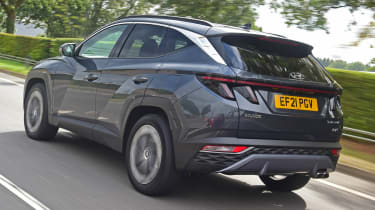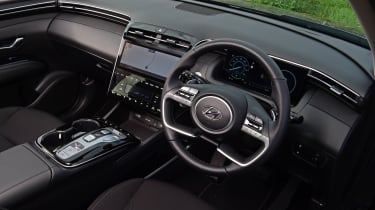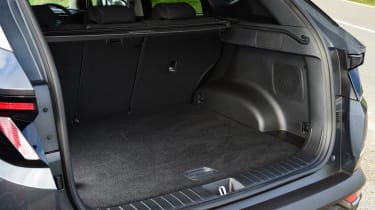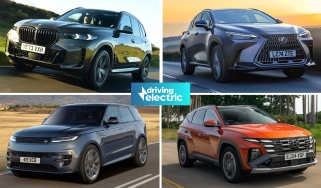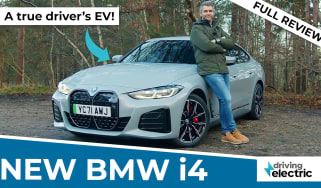Hyundai Tucson Plug-In review
The already impressive Tucson has been elevated by the addition of a plug-in hybrid powertrain, although it costs a pretty penny more than the regular hybrid
Pros
- One-of-a-kind looks
- Premium-feeling cabin
- Dual-screen infotainment
Cons
- Price increase over full hybrid
- Slightly reduced boot space
- Engine noise
| Car type | Electric range | Fuel economy | CO2 emissions |
|---|---|---|---|
| Plug-in hybrid | 38 miles | 202mpg | 31g/km |
The Hyundai Tucson is a thoroughly impressive family car, and is now available with both full-hybrid and plug-in hybrid power. The latter promises even better efficiency of over 200mpg and an electric driving range of 38 miles thanks to a 13.8kWh battery.
That battery feeds a single electric motor that’s also more powerful than the one in the full hybrid, but it’s coupled with the same 1.6-litre turbocharged four-cylinder petrol engine. Total power output stands at 261bhp and 350Nm of torque, with 0-62mph taking 8.6 seconds. That's slightly slower than the full-hybrid, which is likely down to the larger, heavier battery. Plus, straight-line performance isn’t this electrified family hauler’s top priority.
Instead, it’s all about the ‘fill’ the electric motor adds, and the instant torque it provides, making this Tucson swift off the line. But the plug-in hybrid is also relaxing to cruise around town in, with no flaring of revs from the engine as the gearbox handles the transmission of power to the road. And even on our test car’s 19-inch alloy wheels, the suspension soaked up the imperfections of urban UK roads in a highly composed fashion.
The Hyundai’s light steering makes it easier to manoeuvre in tight spots, too. The plug-in Tucson is certainly not the most dynamic machine on the road, as the engine gets a little noisy when you put your foot hard down; instead it's more suited to relaxed cruising.
Pushing the car will also prevent you from matching the claimed efficiency numbers: in official testing, it returned nearly 202mpg while emitting just 31g/km of CO2 – although remembering to plug in as frequently as possible will go a long way towards getting close to those figures. But even if you don't, the Tucson Plug-In should be an extremely affordable family SUV to run, especially if you’re a company-car driver, thanks to its 11% Benefit-in-Kind (BiK) tax rate, compared to 29% for the full-hybrid version.
Thankfully, the plug-in hybrid version isn't compromised when it comes to interior space, offering the same room in the rear that made the Tucson such a hit when we first drove it. Plus, the cabin features an array of premium materials, a great sense of space thanks to the dashboard design and a pair of 10.25-inch screens up front that boast sharp graphics and are quick to respond to inputs.
You also get 558 litres of boot space, which is slightly down on the 616-litre capacity of the full-hybrid due to the packaging required for the larger battery in the plug-in. But that’s still more than the 390 litres the recently facelifted Vauxhall Grandland PHEV offers, or the similarly electrified Toyota RAV4's 520-litre boot capacity, so we think the Tucson's will be more than adequate.
Thanks to that larger 13.8kWh battery, during our time with the car we easily achieved 30 miles of pure-electric running. With a 7.2kW on-board charger, fully topping up the battery from a home wallbox or public point will take around an hour and three-quarters.
Of course, you do pay for that extra zero-emissions driving range and superior fuel economy. Our Tucson Plug-In test car came in Premium trim – the cheapest of four options – but it was well over £4,500 more expensive than the full-hybrid model in the same spec.
However, along with the more efficient powertrain, you get 18-inch alloy wheels, climate control, high-beam assist, smart adaptive cruise control, all-round parking sensors with a rear-view camera, full keyless go, heated seats and a heated steering wheel. There's also that 10.25-inch digital dashboard and 10.25-inch central touchscreen, with Apple CarPlay, Android Auto and wireless smartphone charging all thrown in.
Safety technology is great, too, with lane-following and lane-keeping assistance, along with autonomous emergency braking featuring pedestrian and cyclist detection, rear cross-traffic alerts and many more protective systems fitted as standard. And there's Hyundai’s comprehensive five-year/unlimited-mileage warranty.
We still can’t ignore the plug-in hybrid Tucson’s higher price tag compared to the full-hybrid model, and for that reason the latter may be the better bet for some because it’s more affordable. But overall, the plug-in is well worth a look if you're in the market for an electrified family SUV.
It has the same spacious and premium-feeling cabin, impressive in-car technology and refined road manners as the full-hybrid, with the latter elevated even further around town by the Plug-In's electric range. Its efficiency also exceeds that of many rivals – as long as you remember to keep the battery topped up to maximise economy.

